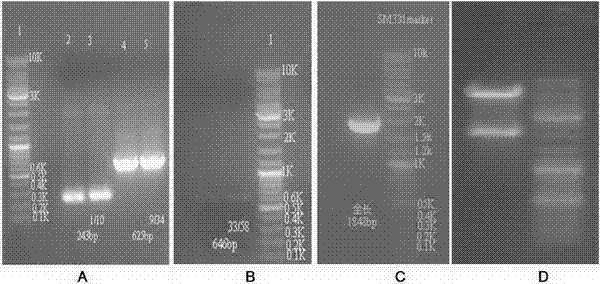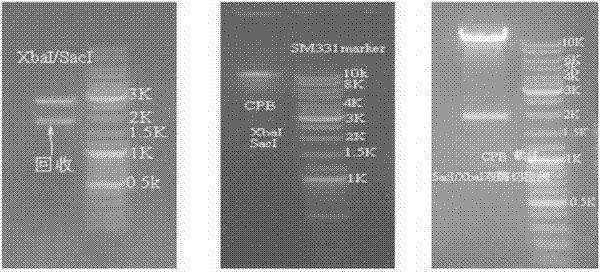Artificially synthesized Bt insect-resistant gene Cry1Ab-t and application thereof
A technology of cry1ab-t and insect-resistant genes, which is applied in the fields of application, genetic engineering, and plant gene improvement, can solve the problems of poor insect resistance, unstable expression products, and low expression levels, so as to reduce usage and enhance Expression, the effect of broad application prospects
- Summary
- Abstract
- Description
- Claims
- Application Information
AI Technical Summary
Problems solved by technology
Method used
Image
Examples
Embodiment 1
[0025] Example 1 Cry1Ab-t Gene design and artificial synthesis
[0026] Cry1Ab-t Bt gene Cry1Ab On the basis of the original nucleotide sequence of the original nucleotide sequence, a part of the N-terminal 1845bp base sequence SEQ ID No.2 is left, and the preference of the plant gene is adopted while the amino acid composition of the retained sequence remains unchanged. Codon replacement of the corresponding codons of the original Bt, elimination of ATTTA, AATGAA and other AT-rich sequences and ambiguous intron sequences in the Bt gene, and deletion of large inverted repeat sequences and commonly used restriction enzymes in the gene Identify the site sequence, design the coding sequence of the target synthetic Bt gene as shown in the sequence table SEQ ID No.1.
[0027] Blast2 comparison analysis of the original Bt insect-resistant gene Cry1Ab and the synthetic new Bt gene Cry1Ab-t nucleotide coding sequence found that the 1845 bp nucleotide sequence at the 5' end was hom...
Embodiment 2
[0058] Example 2 Expression of Cry1Ab-t gene in Escherichia coli cells and detection of toxicity of expression products
[0059] In order to quickly detect the toxicity of the newly modified Bt insect-resistant protein Cry1Ab-t to corn borer, we constructed a prokaryotic expression vector of the Cry1Ab-t gene to detect the toxicity of the insect-resistant protein Cry1Ab-t in vitro.
[0060] Plasmid pUC1Ab-t was provided by Shanghai Bioengineering Company, containing Cry1Ab-t Gene. According to build Cry1Ab-t The gene prokaryotic expression vector needs to be added at the 5' end of the primer sequence Nd Endonuclease recognition site sequence CATATG, 3-end addition Hind III Endonuclease recognition site sequence AAGCTT. The designed primer sequence is (as shown in SEQ ID NO: 4, 5):
[0061] Upstream primer F1: 5-CATATGGACAACAACCCAAACATC-3
[0062] Downstream primer R1: 5-AAGCTTCTAGTACTCAGCCTCGAATG-3
[0063] The prokaryotic expression vector is pET-28b from Novgen Comp...
Embodiment 3
[0078] Example 3 Plant Transgenic Vector Construction and Agrobacterium Transformation
[0079] The first step: use wxya , SacI Enzyme cut T vector plasmid pUC Cry1Ab-t , recovered with a gel recovery purification kit Cry1Ab-t fragment.
[0080] Step two: use wxya , SacI Digest the plant expression vector CPB, and recover the digested CPB fragments with a gel extraction and purification kit.
[0081] Step 3: Ligate the purified two fragments to construct the plant expression vector pCAMBIA1300- Cry1Ab-t - bar (see figure 2 ), the enzyme was digested and identified, indicating that the vector was constructed correctly (see image 3 ).
[0082] Agrobacterium-mediated genetic transformation (strain LBA4404) was used to transform maize callus and immature embryos. Cry1Ab-t In the gene maize genome, transgenic plants were obtained after screening with the herbicide bialaphos, and transplanted after screening, regeneration, and seedling hardening (see Figure 4 ), ...
PUM
 Login to View More
Login to View More Abstract
Description
Claims
Application Information
 Login to View More
Login to View More - R&D
- Intellectual Property
- Life Sciences
- Materials
- Tech Scout
- Unparalleled Data Quality
- Higher Quality Content
- 60% Fewer Hallucinations
Browse by: Latest US Patents, China's latest patents, Technical Efficacy Thesaurus, Application Domain, Technology Topic, Popular Technical Reports.
© 2025 PatSnap. All rights reserved.Legal|Privacy policy|Modern Slavery Act Transparency Statement|Sitemap|About US| Contact US: help@patsnap.com



